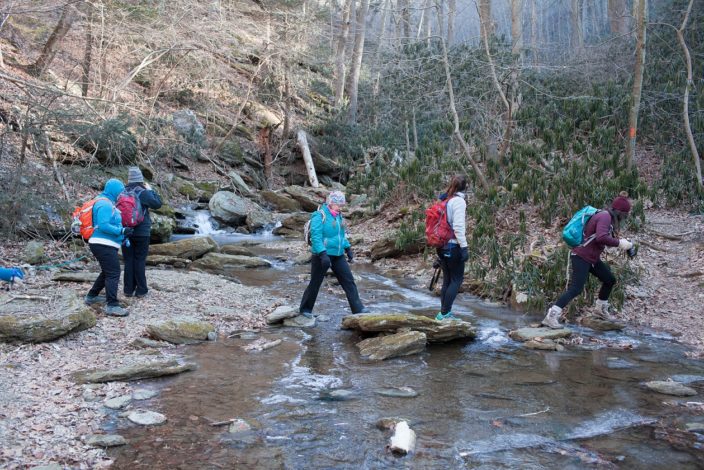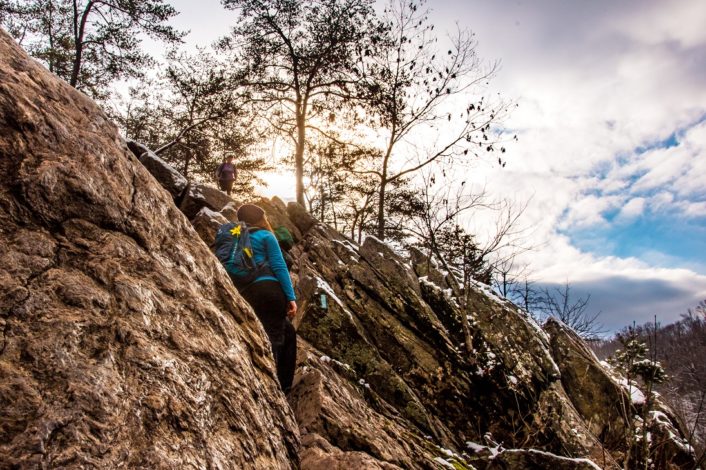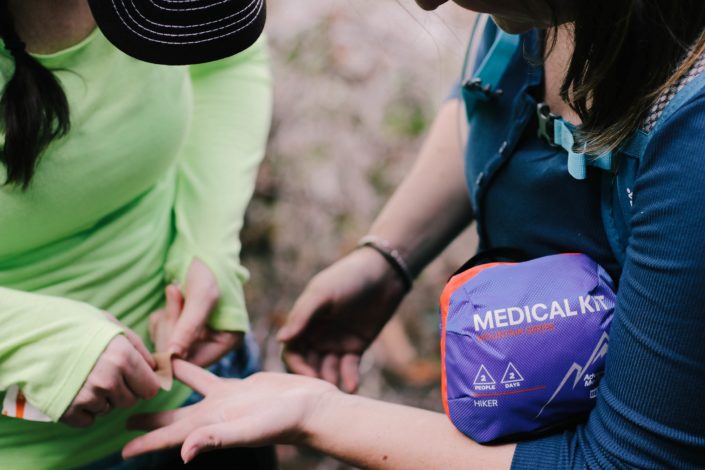Hiking Essentials: Staying Safe on the Trail
- Blog Hiking Essentials: Staying Safe on the Trail
“Hike safely!” These are the words that always come out of my mother’s mouth when I call her to relay the details of our next hiking adventure. But what does it mean to “hike safely”? We recently discussed the essential and recommended gear to bring on a hike (you can access the article here); but while the gear is a huge part of hiking safely, there is more to this concept than just bringing a bunch of stuff with you on a hike. That’s why in part two of our “Hiking Essentials” series, we tackle the topic of staying safe on the trail. We'll discuss general safety preparations first before diving into (and providing extra resources for) four of the main hiking safety concerns: injury, animals, potentially dangerous humans and weather.
 Photo by Kendra Reeder.
Photo by Kendra Reeder.
General Trail Safety Preparation
Both hiking enthusiasts and park officials generally recommend hiking in groups of two or more. This is especially important for hikes with higher mileage or elevation gain or if you are new to hiking. Staying in a group could be a life-saving decision should a dangerous situation arise during a hike. That being said, I can also see the appeal of the quiet serenity that can come with solo hiking. Regardless whether you prefer solo or group hiking, most safety concerns can be mitigated with the proper preparation and planning. This concept is illustrated by a study from the Journal of Travel Medicine that focused on the trends of search and rescue (SAR) deployment in U.S. National Parks. The authors of the study came to the conclusion that errors in judgment, fatigue/physical condition and insufficient experience, equipment and/or clothing were the most common contributing factors for SAR missions. The following are some general trail safety tips to help with the pre-hike preparation in order to help avoid dangerous situations. 1. Carry the essentials: Check out this article for a list of essentials and recommended items. 2. Research the area: While some trail surprises can make for fun memories (Who doesn’t love a hidden waterfall?!), others can turn a seemingly easy walk in the woods into a nightmarish experience. Take note to watch for things like expected elevation changes, the terrain, trail status, hunting season and wildlife. This can minimize unwanted surprises during the hike. It can also tell you if extra essentials are needed for your hike. These may include bear mace in bear country or bright orange clothing during hunting season. 3. Know the current terrain status: This can be especially important in the winter when cold temperatures and snow/freezing rain can completely change the terrain of a trail, making the use of micro-spikes or snowshoes a must. Spring and summer can also play havoc on a trail due to the overgrowth of plants. Here in the Southern Adirondacks, there are certain trails that are so overgrown at times that the use of bright tree markers is required if you want to bushwhack your way to a peak and not get lost on the way back down the mountain. 4. Always be aware of your surroundings: Try to avoid wearing earbuds or headphones or carrying a bluetooth speaker with you on a hike. It can be a pretty dangerous habit to have on the trail because many of the warning signs from potentially dangerous animals, other hikers and even weather changes (such as distant thunder) come in the form of sounds. The same goes for talking on the phone, texting and scrolling through photos while hiking since these distractions can prevent you from seeing tree roots, steep ledges and even animals (such as a snake sunning itself on the trail). 5. Know your limits: As I mentioned earlier, lack of experience, along with fatigue and physical condition, are among the most common reasons for a search and rescue team to be deployed. While I absolutely agree that pushing your limits can get you far, there is a fine line between going a bit farther than you did last week and pushing yourself to complete exhaustion. For example, I know that I tend to forget about my limits when I'm trying to keep up with more experienced hikers. This has put me in a difficult spot more than once. It took me passing out on the trail to realize that the only person I should be “competing” with is myself. From that point on, hikes have become more about the experience along the way rather than making it to a peak quickly. Photo by Jessica Human.
Photo by Jessica Human.
Injury
One of the biggest fears when hiking is the risk of injury. Did you know, though, that many hiking injuries can be avoided or easily treated with the proper preparation and gear? Here are some tips for preventing or treating some common hiking ailments: 1. Stretching once your muscles are warmed up can help prevent muscle cramps, lower back pain, foot arch pain, etc. I like to walk around the trailhead to warm up a bit before stretching. 2. Hydrating before and during a hike can help prevent headache, over-exhaustion, altitude sickness and stomach problems. 3. Wearing boots with ankle protection and using trekking poles can help prevent twisted or sprained ankles. It also helps stabilize you to prevent falls. 4. Wearing long sleeves and pants can help prevent sunburn, bug bites (especially if the clothing is treated with repellent) and contact with poison ivy or oak. 5. Carrying a well-stocked first-aid kit that includes things like moleskin (for blisters), insect sting-relief pads, pain-relief meds, etc., can treat most hiking-related injuries. While it is best to avoid injury, some mishaps will happen no matter how prepared you are (especially if you tend to be clumsy like me!). So what should you do if the injury is more severe and you cannot continue with your hike? These injuries could include broken bones or severe sprains, hypothermia (cooling of the core temperature below 95 degrees Fahrenheit), heatstroke, falls that result in loss of consciousness, etc. In these cases, you need to call in the big guns. Dialing 911 will connect you with the proper channels and get search and rescue teams to your aid. And although many hiking spots have little to no cell service available, attempting to call emergency services from your cell phone can leave a data trail for rescue services to find you. This is true even if your call didn’t go through. While it may take rescue teams longer to find you, it is an important reason to always carry a cell phone on hikes if you have one. If you tend to hike far from cell service on a regular basis, a better option may be to invest in either a Personal Locator Beacon (PLB) or a satellite messenger. Both of these devices use satellite-based technology to transmit messages to emergency services, though a PLB is designed to send out a distress signal while satellite messengers allow you to send short messages or your location coordinates. Check out this expert advice article from REI for more information on these devices. Are you looking to gain some wilderness first-aid skills? Check out this online course presented by Backpacker Magazine to learn how to handle medical problems and emergency situations in the wilderness. Photo by Kristin Hinnant.
Photo by Kristin Hinnant.
Animal Encounters
When I think of animal risks on the trail, I’m always reminded of the saying at the end of every episode of the old G.I. Joe TV show from the ’80s: “Knowing is half the battle.” Each hiking area usually comes with a unique set of animals to watch out for. It might be black bears along the Colorado Front Range or timber rattlesnakes in the Southern Adirondacks. Knowing which potentially harmful animals are in your area is the first step to avoiding an encounter or determining what to do if one happens to cross your path. It’s a universal rule that you should never approach a wild animal (not exactly the opportune time for a selfie!). However, each animal comes with a unique set of signs to look out for and solutions for avoiding an attack. We have listed some of the most common wild animals to watch out for along with some helpful resources specific to each animal. 1. Bears: Living along the Front Range in Colorado, we tended to see black bears pretty frequently along trails and in neighborhoods foraging for food. Growing up, I remember one particular incident where a bear cub was digging through the trash can in our garage before mama bear fetched him to continue down the road into the woods. So what do you do if you encounter a bear on a trail? Here and here are a couple articles that discuss the signs to look out for, precautions to take and what to do should you encounter a bear while hiking in bear country. 2. Snakes: As much as they fascinate me, I also have a somewhat irrational fear of snakes because I have encountered numerous snakes while hiking. Almost all of them were non-venomous and way more interested in getting away from me rather than attacking. That said, knowing which species to look out for and what to do if you come across a venomous species while on the trail is extremely important. Check out these articles on the do’s and don’ts of hiking in rattlesnake territory and expert snake safety advice for more information. 3. Mountain lions: Also known as cougars, pumas and panthers, mountain lions are extremely widespread throughout the Western Hemisphere. That being said, it is generally rare to encounter a mountain lion on a hike. Here are some tips from the National Park Service for how to avoid an encounter and what to do should you come across a mountain lion on a hike. 4. Ticks: While ticks may not strike fear in your heart, the diseases they can transmit should. I live in an area that shows one of the highest occurrences of Lyme disease in the nation, so protection in the form of insect repellent, long sleeves and pants, and tick checks is very important. This article discusses important information on preventing, removing and testing ticks. PLEASE NOTE: It is important to report any animal sightings to park personnel, especially if the sightings occur close to the trail! Contact information can almost always be found at trailheads and parking lots.Human Encounters
We have all heard stories of hikers being attacked by other people on trails around the nation. However, while there are no set statistics on violent crimes against hikers, the likelihood of being attacked by another human being on a trail is extremely rare. In fact, public lands tend to be much safer than the rest of the country. The risk of violent crimes is thousands of times lower than in the country as a whole. That said, there are a few precautions you can take to be prepared (and provide yourself some peace of mind) should you encounter someone with potentially questionable intentions: 1. Be wary of people who don’t “look like hikers.” For example, if you are on a lengthy hike and notice someone who appears ill-equipped for the terrain (such as lack of gear or inappropriate clothing), it may be best to give them plenty of distance. 2. Carry some items that can be used as weapons close at hand. This could include bear mace and/or a hiking knife attached to a belt loop or the outside of your hiking pack. Even trekking poles can make powerful weapons. Speaking from personal experience with an overzealous toddler, getting struck in the kneecap with a pole can be extremely painful (it was purely accidental on his part).Weather Safety
Mother Nature is unpredictable. It isn’t possible to know with absolute certainty what she will throw your way on a hike. However, a little forward thinking can help prevent you from being left out in the cold, rain or heat. 1. Precautions for winter- Are you hiking over an area with a frozen body of water, but unsure of the safety of the ice? With large bodies of water, you'll want to be sure that the ice thickness has been tested before venturing onto it. However, when hiking in areas with frozen rivers, creeks, etc., you can test the ice yourself before putting your whole weight on it. Just remember the old saying: “Thick and blue, tried and true. Thin and crispy, way too risky.”
- Be aware of snow squalls – periods of sudden moderate to heavy snowfall accompanied by strong surface winds (aka whiteouts). They can severely reduce visibility and create slippery surfaces. Most snow squalls are brief, so it is best to stay put if you are caught in one to avoid losing the trail and getting lost.
- Frostbite can occur during prolonged exposure of the extremities to temperatures below freezing. It can range in severity from superficial redness to severe skin discoloration and blisters. If frostbite occurs, it is important to seek medical attention as soon as possible. Also, refrain from rubbing the affected skin, as this can cause further damage.
- Are you hiking in an area that may be prone to avalanches? Check out this article to learn more about avalanche safety.
- Start your hike early in the day when temperatures are lower, and cover up with long sleeves, pants and a hat. This may sound counterintuitive, but the less skin that is exposed to damaging UV rays, the better!
- Hydrate well throughout your hike (especially if you tend to sweat a lot like I do) by sipping water often. Just be sure to avoid any chugging contests during your hike. Drinking too much water at once can actually do more harm than good because our bodies can only absorb about a half a liter of water every hour.
- Since our bodies are losing more than just water when we sweat, eating the right snacks can make a huge difference! Replenishing lost electrolytes can be as simple as noshing on some trail mix or sucking down some carb and electrolyte-rich sports gels. Snack breaks are great times to chill out in the shade and give your muscles a chance to recover while also letting the evaporation of sweat cool down your body temperature.
- Know the signs of heatstroke. This condition is caused by the overheating of the body, usually above 104 degrees Fahrenheit, as a result of physical exertion or overexposure to high temperatures. Symptoms of heatstroke may include confusion or agitation, severe headache, muscle cramps, nausea/vomiting, rapid heart-rate and/or breathing, and lack of sweating. Heat stroke can be deadly, and it’s important to find shade and cool down as soon as possible. Extra medical attention may be needed as well, so don’t hesitate to call in emergency services if needed!
- Watch for darkening clouds and increasing wind speeds, which could indicate an incoming thunderstorm. (The white, fluffy clouds are safe as long as they stay white and fluffy and don’t start growing upwards toward space!)
- If possible, find a safe shelter that has four walls, a roof and wiring. (Camping lean-tos and picnic pavilions are NOT safe shelters.) A fully enclosed metal-topped vehicle is also considered safe, so if you are close to the parking lot, making a break for your car is the best bet!
- If shelter is not an option, avoid open areas and bodies of water, immediately leave elevated areas (hills, peaks, etc.) and try not to be the tallest object in the area. Avoid tall or isolated trees, as well, as they tend to act as homing beacons for lightning strikes. Also stay away from objects that conduct electricity, such as barbed wire fences.
- If you are hiking in a group, spread out. While this doesn’t decrease the odds that someone will get struck, it does help prevent multiple casualties so that help is available if someone is struck.
Read More:
What other safety tips or concerns do you have regarding hiking? Let us know in the comments below!THIS ARTICLE IS WRITTEN FOR HIKE IT BABY AS AN INFORMATIONAL TOOL FOR READERS. WE ARE NOT EXPERTS IN THIS FIELD AND REFER READERS TO THEIR PERSONAL HEALTHCARE PROVIDERS WHEN SEEKING ADVICE ON MEDICAL MATTERS.
Related Content




Comments